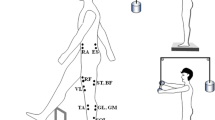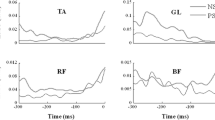Abstract
We used the framework of the uncontrolled manifold (UCM) hypothesis to analyze multi-muscle synergies involved in making a step by a standing person. We hypothesized that leg and trunk muscles are organized into stable groups (muscle modes, M-modes) related to shifts of the center of pressure (COP) in the anterior-posterior and medio-lateral directions. Another hypothesis was that the magnitudes of the modes co-vary across repetitive trials to stabilize a certain magnitude of the COP shift in both directions. M-modes were defined using principal component analysis applied to indices of changes in the electromyographic (EMG) activity prior to releasing variable loads that were held by the subject using a pulley system. For the task of releasing the load behind the body three M-modes associated with a backward COP shift were defined. Four M-modes were defined for the task of releasing the load at the body side associated with a lateral COP shift. Multiple regression analysis was used to relate changes in the M-mode magnitudes to COP shifts. EMG changes prior to making a step were quantified over five 100 ms time windows before the lift-off of the stepping leg. Two components of the variance in the M-mode space computed across repetitions of a stepping task were quantified—a component that did not affect the average COP shift in a particular direction (variance within the UCM, V UCM), and a component that affected the COP shift (variance orthogonal to the UCM, V ORT). V UCM was significantly higher than V ORT for both directions of the COP shifts. This relation was observed for the M-modes in the stepping leg as well as in the support leg. The stepping leg showed a different time evolution of the ratio V UCM/V ORT such that the difference between the two variance components disappeared closer to the time of the lift-off. The findings corroborate both main hypotheses. The study supports a view that control of whole-body actions involves grouping the muscles, using fewer elemental variables to scale the muscle activity, and forming synergies in the space of the elemental variables that stabilize time profiles of important performance variables.








Similar content being viewed by others
References
Alexandrov A, Frolov A, Massion J (1998) Axial synergies during human upper trunk bending. Exp Brain Res 118:210–220
Allum JH, Honegger F (1993) Synergies and strategies underlying normal and vestibulary deficient control of balance: implication for neuroprosthetic control. Prog Brain Res 97:331–348
Allum JH, Honegger F, Pfaltz CR (1989) The role of stretch and vestibulo-spinal reflexes in the generation of human equilibrating reactions. Prog Brain Res 80:399–409
Aruin AS, Latash ML (1995) The role of motor action in anticipatory postural adjustments studied with self-induced and externally triggered perturbations. Exp Brain Res 106:291–300
Aruin AS, Latash ML (1996) Anticipatory postural adjustments during self-initiated perturbations of different magnitude triggered by a standard motor action. Electroencephalog Clin Neurophysiol 101:497–503
Baratto L, Morasso PG, Re C, Spada G (2002) A new look at posturographic analysis in the clinical context: sway-density versus other parameterization techniques. Motor Control 6:246–270
Bouisset S, Lestienne F, Maton B (1977) The stability of synergy in agonists during the execution of a simple voluntary movement. Electroencephalogr Clin Neurophysiol 42:543–551
Burleigh AL, Horak FB, Malouin F (1994) Modification of postural responses and step initiation: evidence for goal-directed postural interactions. J Neurophysiol 72:2892–2902
Collins JJ, De Luca CJ (1993) Open-loop and closed-loop control of posture: a random-walk analysis of center-of-pressure trajectories. Exp Brain Res 95:308–318
Couillandre A, Breniere Y, Maton B (2000) Is human gait initiation program affected by a reduction of the postural basis? Neurosci Lett 285:150–154
Crenna P, Frigo C (1991) A motor programme for the initiation of forward-oriented movements in humans. J Physiol 437:635–653
Crenna P, Frigo C, Massion J, Pedotti A (1987) Forward and backward axial synergies in man. Exp Brain Res 65:538–548
Danion F, Schöner G, Latash ML, Li S, Scholz JP, Zatsiorsky VM (2003) A force mode hypothesis for finger interaction during multi-finger force production tasks. Biol Cybern 88:91–98
Domkin D, Laczko J, Jaric S, Johansson H, Latash ML (2002) Structure of joint variability in bimanual pointing tasks. Exp Brain Res 143:11–23
Hair JF, Anderson RE, Tatham RL, Black WC (1995) Factor analysis. In: Borkowsky D (ed) Multivariate data analysis. Prentice Hall, Englewood Cliffs, pp 364–404
Halliday S, Winter D, Frank J, Patla A (1998) The initiation of gait in young, elderly, and Parkinson’s disease subjects. Gait Posture 8:8–14
Holdefer RN, Miller LE (2002) Primary motor cortical neurons encode functional muscle synergies. Exp Brain Res 146:233–243
Horak FB, Nashner LM (1986) Central programming of postural movements: adaptation to altered support-surface configurations. J Neurophysiol 55:1369–1381
Hughlings Jackson J (1889) On the comparative study of disease of the nervous system. Brit Med J, Aug 17:355–362
Jian Y, Winter D, Ishac M, Gilchrist L (1993) Trajectory of the body COG and COP during the initiation and termination of gait. Gait Posture 1:9–22
Krishnamoorthy V, Goodman S, Zatsiorsky VM, Latash ML (2003a) Muscle synergies during shifts of the center of pressure by standing persons: identification of muscle modes. Biol Cybern 89:152–161
Krishnamoorthy V, Latash ML, Scholz JP, Zatsiorsky VM (2003b) Muscle synergies during shifts of the center of pressure by standing persons. Exp Brain Res 152:281–292
Krishnamoorthy V, Latash ML, Scholz JP, Zatsiorsky VM (2004) Muscle modes during shifts of the center of pressure by standing persons: effect of instability and additional support. Exp Brain Res 157:18–31
Kutch JJ, Buchanan TS (2001) Human elbow joint torque is linearly encoded in electromyographic signals from multiple muscles. Neurosci Lett 311:97–100
Latash ML, Scholz JF, Danion F, Schöner G (2001) Structure of motor variability in marginally redundant multi-finger force production tasks. Exp Brain Res 141:153–165
Latash ML, Scholz JP, Schöner G (2002) Motor control strategies revealed in the structure of motor variability. Exer Sport Sci Rev 30:26–31
Latash ML, Danion F, Scholz JF, Schöner G (2003) Coordination of multi-element motor systems based on motor abundance. In: Latash ML, Levin MF (eds) Progress in Motor Control vol.3 Effects of Age, Disorder, and Rehabilitation, Human Kinetics, Urbana, IL, pp 97–124
Li ZM, Latash ML, Zatsiorsky VM (1998) Force sharing among fingers as a model of the redundancy problem. Exp Brain Res 119:276–286
Massion J (1992) Movement, posture and equilibrium: interaction and coordination. Prog Neurobiol 38:35–56
Mickelborough J, Linden ML, Tallis RC, Ennos AR (2004) Muscle activity during gait initiation in normal elderly people. Gait Posture 19:50–57
Moore KL (1992) Clinically oriented anatomy. Williams and Wilkins, Baltimore, pp 385–417
Nashner LM (1976) Adapting reflexes controlling human posture. Exp Brain Res 26:59–72
Nashner LM (1979) Organization and programming of motor activity during posture control. In: Granit R, Pompeiano O (eds) Reflex control of posture and movement. Elsevier, Amsterdam, pp 177–184
Nashner LM, Cordo PJ (1981) Relation of automatic postural responses and reaction-time voluntary movements of human leg muscles. Exp Brain Res 43:395–405
Neptune RR, Zajac FE, Kautz SA (2004) Muscle force redistributes segmental power for body progression during walking. Gait Posture 19:194–205
Sabatini AM (2002) Identification of neuromuscular synergies in natural upper-arm movements. Biol Cybern 86:253–262
Schieber MH, Santello M (2004) Hand function: peripheral and central constraints on performance. J Appl Physiol 96:2293–2300
Scholz JP, Schöner G (1999) The uncontrolled manifold concept: identifying control variables for a functional task. Exp Brain Res 126:289–306
Scholz JP, Schöner G, Latash ML (2000) Identifying the control structure of multijoint coordination during pistol shooting. Exp Brain Res 135:382–404
Scholz JP, Danion F, Latash ML, Schöner G (2002) Understanding finger coordination through analysis of the structure of force variability. Biol Cybern 86:29–39
Slijper H, Latash ML (2000) The effects of instability and additional hand support on anticipatory postural adjustments in leg, trunk, and arm muscles during standing. Exp Brain Res 135:81–93
Winter DA, Mackinnon CD, Ruder GK, Wieman C (1993) An integrated EMG/biomechanical model of upper balance and posture during human gait. Prog Brain Res 97:359–367
Winter DA, Prince F, Frank JS, Powell C, Zabjek KF (1996) Unified theory regarding A/P and M/L balance in quiet stance. J Neurophysiol 75:2334–2343
Zajac FE, Gordon ME (1989) Determining muscle’s force and action in multi-articular movements. Exer Sport Sci Rev 17:187–230
Zatsiorsky VM, Duarte M (1999) Instant equilibrium point and its migration in standing tasks: rambling and trembling components of the stabilogram. Motor Control 3:28–38
Zatsiorsky VM, Duarte M (2000) Rambling and trembling in quiet standing. Motor Control 4:185–200
Zatsiorsky VM, Li Z-M, Latash ML (1998) Coordinated force production in multi-finger tasks. Finger interaction and neural network modeling. Biol Cybern 79:139–150
Zatsiorsky VM, Li Z-M, Latash ML (2000) Enslaving effects in multi-finger force production. Exp Brain Res 131:187–195
Acknowledgments
The authors are grateful to Siripan Siwasakunrat for her help in running the experiments. Preparation of this paper was supported in part by NIH grants AG-018751, NS-35032, and AR-048563.
Author information
Authors and Affiliations
Corresponding author
Rights and permissions
About this article
Cite this article
Wang, Y., Zatsiorsky, V.M. & Latash, M.L. Muscle synergies involved in shifting the center of pressure while making a first step. Exp Brain Res 167, 196–210 (2005). https://doi.org/10.1007/s00221-005-0012-3
Received:
Accepted:
Published:
Issue Date:
DOI: https://doi.org/10.1007/s00221-005-0012-3




